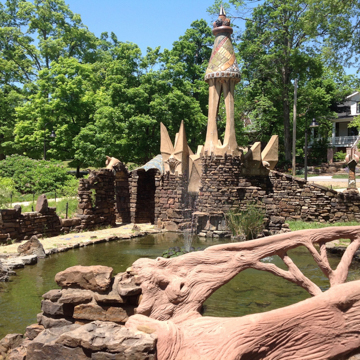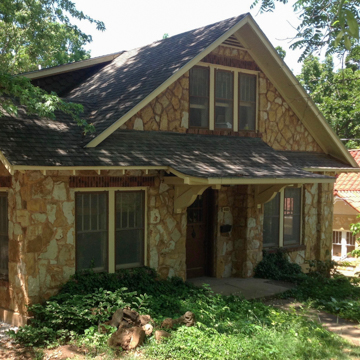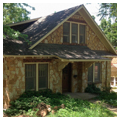Fayetteville’s oldest city park traces to the beginnings of the twentieth century, initially as a few acres centered on what was then called Trent’s Pond, a swimming hole later filled and serving today as a softball field. Enlarged in area to its current size of nearly twenty-three acres, Wilson Park includes among its many features an assembly of structures collectively known as “The Castle,” a colorful collage of things to climb on, sit on, and walk over, generally sculpted of concrete or covered in tile (or both), in colorful Alice-in-Wonderland scale and shape. Immensely popular with local residents from this neighborhood and beyond, the city continues to add attractions to The Castle, including florally inspired benches, giant worm-like concrete flowerbed edgings, and faux bois footbridges. The whole is a fantasia of public space, more an active event than a tranquil place for reflection.
Once at the periphery of the city, but now in its epicenter, Wilson Park has given its name to the greater surrounding neighborhood, an area as diverse in its architecture as it is in its residents. Some of its most notable architecture was the brainchild of early resident and University of Arkansas geologist Dr. Noah Fields Drake, who developed several nearby lots beginning in the mid-1920s. Known as the “Rock Houses,” the residences along W. Davidson Street and N. Park and Forest avenues built by Drake are readily identifiable by their use of locally quarried sandstone applied to their exteriors perpendicular to its natural state, occasioning the use of the pejorative “giraffe stone” (also called Ozark giraffe) owing to its resemblance to the hides of those creatures. Varying in color from ochre-yellows to deeper orange tones, the earthy stone gives the houses a warm, inviting character. Drake’s own house (c. 1920–1922; 501 Forest Avenue), the first built and the largest of the group, utilized stucco as well as stone for its exterior and was crowned by an exotic red clay tile roof, under which sleeping porches were included for the hottest times of the year. Similar in form and size to the bungalows then popular in Pasadena, California, and other locales around the country, the Rock Houses form an identifiable grouping of residences subtle in their distinctions, romantic in their image. Their hilly, leafy siting contributes to their desirability, as does their frequent inclusion of such features as front porches, deeply set windows, exposed rafter tails, and heavy overhanging roofs. Floral gardens complement the grounds of many of the houses, visually connecting them with the extensively planted beds of neighboring Wilson Park.






















